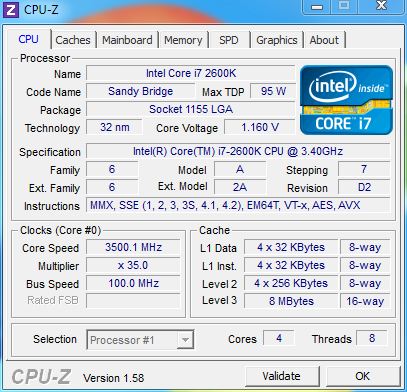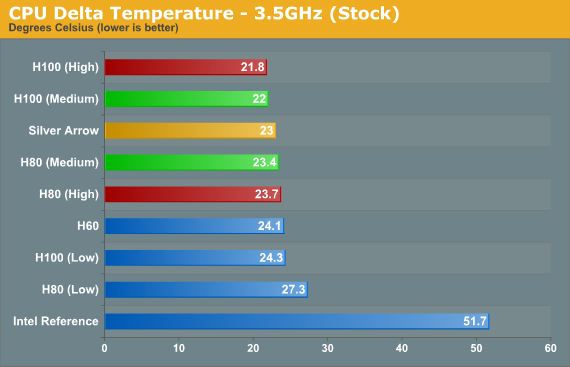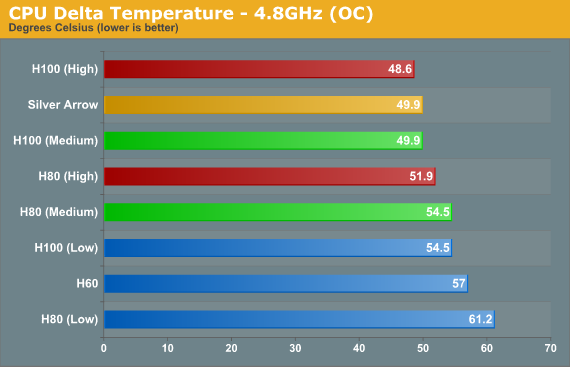Corsair Hydro Series: H60, H80 and H100 Reviewed
by Jared Bell on November 7, 2011 12:00 AM EST- Posted in
- Cases/Cooling/PSUs
- Corsair
- Water Cooling
Temperature Results
Each Corsair Hydro Series cooler is mounted to blow air from outside the case over the radiator. We had to leave the top cover off of our 600T chassis during the H100 tests due to its restrictive design; otherwise the H100 results would have been horrendously skewed. The top cover didn't affect our other tests and was left on for those. Since the H60 has a PWM fan, we disabled any BIOS fan controls to ensure the fan was spinning at 100%. All three of the H80 and H100 speed settings are tested. We’ll start with our stock 3.5GHz test results and then move to the overclocked results.


The stock speed test doesn't provide much of a challenge for any of the Hydro Series coolers, leaving very little gap between them. Not surprisingly, all of the aftermarket coolers simply crush the stock Intel cooler; however, it’s also worth nothing that the Silver Arrow outperforms both the H60 and H80, and nips at the heels of the H100 set to Medium fan speed. Due to the relativity cool temperatures during this test, some of the speed profiles for the H80 and H100 never hit their maximum RPM. This keeps those coolers relatively quiet even when running on high or medium at stock speeds.


Now that we're overclocked to 4.8GHz, these coolers are finally showing a temperature difference worthy of their price difference. Also note that the stock Intel cooler didn’t handle the 4.8GHz load reliably, so we don’t have results for it in this chart. The H100 is the runaway leader here, sporting a comfortable 3.3C lead over the H80. The H60 falls 5.1C shy of the H80—not terrible considering its slimmer radiator and single fan design. The cooling advantage of the H100 on the high setting does come at a penalty though; it's substantially louder as you'll see next in the noise test. The potential spoiler in the midst of these results is the Silver Arrow, once again coming very close to the H100 at a lower price. It’s not without compromises, which we’ll cover in the conclusion.










91 Comments
View All Comments
dagamer34 - Monday, November 7, 2011 - link
Seems that even the lowly H60 is good enough that I should replace the stock fan in my HTPC.**USA** - Monday, November 7, 2011 - link
See: "Corsair H100 Install in 600T case" for effective cooling with push/pull fan configuration.KingstonU - Monday, November 7, 2011 - link
Great review! Been looking for a review to cover these exact topics on comparing pros/cons of high end air-coolers to mainstream water coolers. Thanks!I can see now that the only downside of the high-end air cooling solution compared to these is the weight off the motherboard, but has any motherboard actually failed under the load of one of these heavy air coolers? I supposed you could also just your case on it's side and problem solved.
Beenthere - Monday, November 7, 2011 - link
The HSF back plate is there to distribute the load, so the mobo isn't over-stressed.ajtyeh - Monday, November 7, 2011 - link
any users that have done this? it looks like there may be room for 4 screws to attach an equivlant fanDeath666Angel - Monday, November 7, 2011 - link
Yes, you can use an H60 with 2 fans, but since the radiator is still much more narrow you don't get the same results @ same fan rpm. :-)noeldillabough - Monday, November 7, 2011 - link
I know this must exist, is there a such thing as a case that is covered with fins with liquid channels? We could hook up our videocards and cpu to the loop.Then we'd only hear the noise of the pump; or am I mistaken? Seems like a no brainer but perhaps cost prohibitive.
I've always been scared to do a water cooling system, because of leaks, but I don't see the advantage of this closed loop system quite yet. How reliable are current open loop systems and how much plumbing knowledge do i have to have to get it working safely? I'd love to use it on a dual cpu dual vdeocard setup (four blocks)
Beenthere - Monday, November 7, 2011 - link
You can always build extreme H2O units but why bother when refrigeration systems are far superior and easy.Mjello - Monday, November 7, 2011 - link
I don't remember if it was zalaman who launched a commercial product a few years ago. But that was a tower exactly as you describe. Where the sides was cooling. And heatpipes attached to the sides from the cpu.Anyways. You can do that with h100 and a PII X4 3 Ghz stock speed. If you mount the radiator outside like I did. The temp goes up when you turn off my 900 rpm fan but the system isn't overheating. I'll just check the temps for you for fun ;). Give me half an hour
ggathagan - Monday, November 7, 2011 - link
Yeah, Zalman produced two fanless cases (TNN-500 and TNN-300) that used heatpipes to conduct the heat from internal components to the case.That was different from what noeldillabough is talking about; where you are, in essence, making a case out of radiators.
That would be too cost prohibitive and too complex, especially if you factor in the delicacy of such a case.
Radiator fins and water channels have to be thin to be efficient, and that spells disaster without some sort of protection.
Adding that protection to the outside of a case would add even more complexity and create a nightmare as far as being able to ship it without fear of damage.
There's also the issue of weight to consider and we haven't even started on what customer support would be like.
Zalman still makes the Reserator, which is an external cooling system along the lines of what you mentioned.